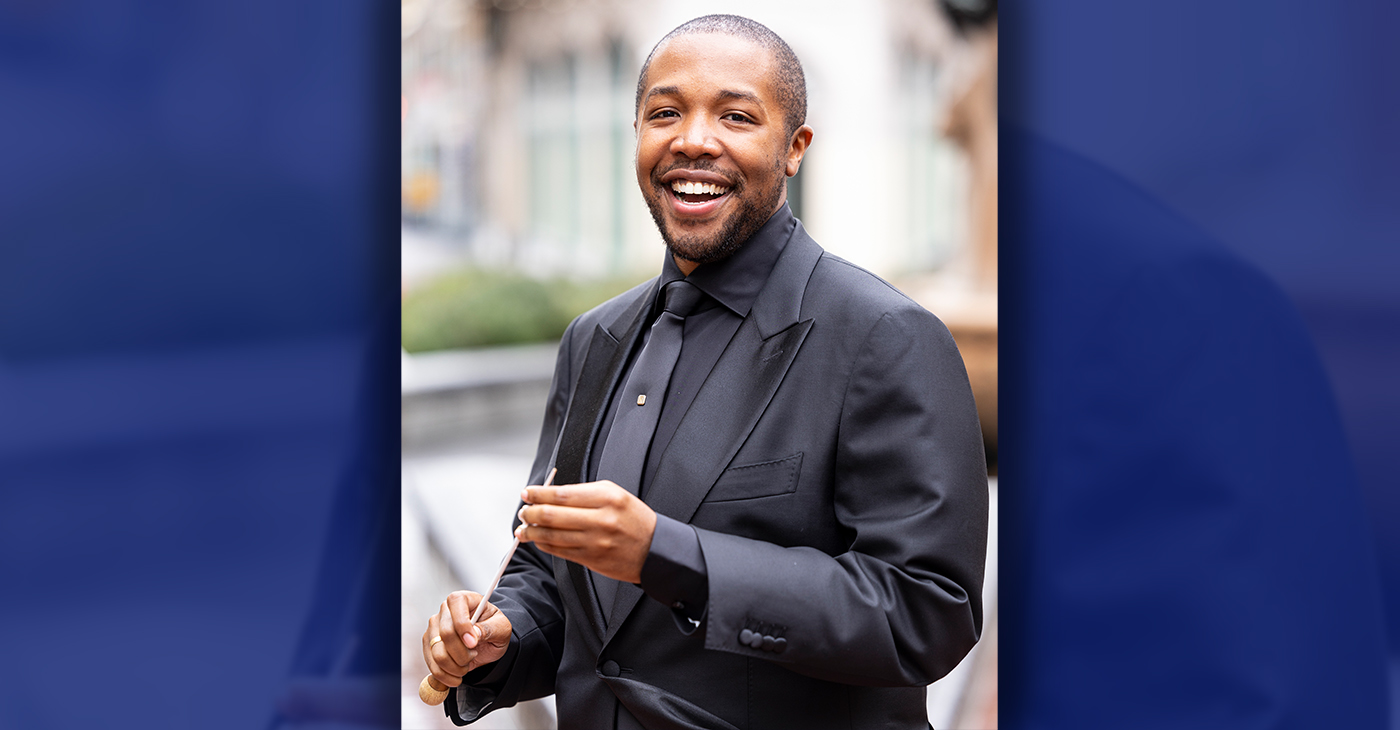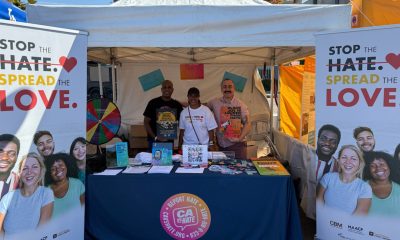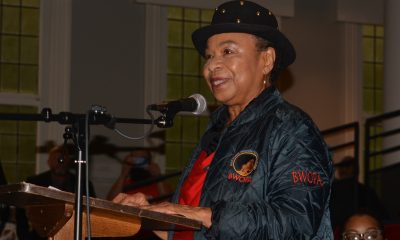Art
Mighty Mighty Art Installation is Centerpiece of Barbershop Project at THEARC
THE AFRO — The barbershop has long been a safe space for certain parts of the Black community – particularly Black men. Artist Devan Shimoyama wanted to take an in-depth look at that relationship in his art installation “Mighty Mighty,” which is the centerpiece of “The Barbershop Project,” a decked out fantastical barber shop offering free haircuts to the community.
The barbershop has long been a safe space for certain parts of the Black community – particularly Black men. Artist Devan Shimoyama wanted to take an in-depth look at that relationship in his art installation “Mighty Mighty,” which is the centerpiece of “The Barbershop Project,” a decked out fantastical barber shop offering free haircuts to the community.
The installation a collaborative effort by Shimoyama, barber Kelly Gorsuch and furniture maker Caleb Woodard, and will run until August 24 at the ARC, 1901 Mississippi Avenue SE.
“Mighty Mighty,” was spun off of a previous body of work, Shimoyama had done in 2017.
“There were all these portraits from young boys to adult men receiving haircuts in a highly aestheticized barbershop with various materials like glitter, rhinestone,” Shimoyama said. “All of that was me, kind of in response to this conversation around toxic masculinity in certain spaces, and thinking of the barbershop where that is certainly present.”
Shimoyama said he had a conversation with friends who expressed frustration with having to “closet” themselves when going into some barbershop.
His work was an attempt to make barbershops “accessible to all of us,” he said.
This time around Shimoyama said the installation is using the same, “material, but creating an immersive experience as if you walked into one of those paintings. So there’s a lot of silk flowers holographic vinyl, rhinestone, glitter.”
“What’s nice about this is it’s also like a social practice or contextual practice version of my paintings,” Shimoyama said. ”They are more accessible to people who may not feel comfortable going to white box gallery spaces and this is planted right in neighborhood right by a community that has this other type of draw for them, and to be able to think of art in a less conventional maybe less elitist way. You can engage it.”
“So that’s really exciting for me.”
Shimoyama said the work’s intent and it’s audience has grown over time.
“So when i made the first iteration I had hoped to spark a dialogue on these issues on all sides of this issues,” Shimoyama said. “Not just queer people, but people who run or work at these spaces who are maybe straight Black men and see this work, and maybe rethink some of their actions in those spaces and help to make a comfortable or safe space for all to enter to.”
“S it ended up as a call to people who identified similarity to me with me. But it didn’t directly interact with people outside of that community which I was hoping to reach out to. So this iteration of that protect already seems more successful at that.”
In addition to “Mighty Mighty” and “The Barbershop Project,” CulturalDC will also offer a slate of summer programming at THEARC all centered on the cultural significance of the barbershop.
“CulturalDC has been looking forward to bringing the Mobile Art Gallery to THEARC for a long time,” said Kristi Maiselman, executive director of CulturalDC in a press release. “The Barbershop Project provides an opportunity to engage with both the wide-ranging resident organizations based at THEARC, and future-minded East of the Anacostia River communities that are informed by D.C.’s rich artistic history. Devan’s work offers a great platform for relevant conversations and engagement around barbershop culture.”
For moe information on the art installation and barbershop hours please go to www.culturaldc.org.
This article originally appeared in The Afro.
Art
Brown University Professor and Media Artist Tony Cokes Among MacArthur Awardees
When grants were announced earlier this month, it was noted that seven of the 22 fellows were African American. Among them are scholars, visual and media artists a poet/writer, historian, and dancer/choreographer who each receive $800,000 over a five-year period to spend as they see fit. Their names are Ruha Benjamin, Jericho Brown, Tony Cokes, Jennifer L. Morgan, Ebony G. Patterson, Shamel Pitts, Jason Reynolds, and Dorothy Roberts. This is the third in the series highlighting the Black awardees.

Special to The Post
When grants were announced earlier this month, it was noted that seven of the 22 fellows were African American. Among them are scholars, visual and media artists a poet/writer, historian, and dancer/choreographer who each receive $800,000 over a five-year period to spend as they see fit. Their names are Ruha Benjamin, Jericho Brown, Tony Cokes, Jennifer L. Morgan, Ebony G. Patterson, Shamel Pitts, Jason Reynolds, and Dorothy Roberts. This is the third in the series highlighting the Black awardees. The report below is excerpted from the MacArthur Fellows web site.
Tony Cokes
Tony Cokes, 68, is a media artist creating video works that recontextualize historical and cultural moments. Cokes’s signature style is deceptively simple: changing frames of text against backgrounds of solid bright colors or images, accompanied by musical soundtracks.
Cokes was born in Richmond, Va., and received a BA in creative writing and photography from Goddard College in 1979 and an MFA from Virginia Commonwealth University in 1985. He joined the faculty of Brown University in 1993 and is currently a professor in the Department of Modern Culture and Media.
According to Wikipedia, Cokes and Renee Cox, and Fo Wilson, created the Negro Art Collective (NAC) in 1995 to fight cultural misrepresentations about Black Americans.[5]
His work has been exhibited at national and international venues, including Haus Der Kunst and Kunstverein (Munich); Dia Bridgehampton (New York); Memorial Art Gallery University of Rochester; MACRO Contemporary Art Museum (Rome); and the Carpenter Center for the Visual Arts (Harvard University), among others.
Like a DJ, he samples and recombines textual, musical, and visual fragments. His source materials include found film footage, pop music, journalism, philosophy texts, and social media. The unexpected juxtapositions in his works highlight the ways in which dominant narratives emerging from our oversaturated media environments reinforce existing power structures.
In his early video piece Black Celebration (A Rebellion Against the Commodity) (1988), Cokes reconsiders the uprisings that took place in Black neighborhoods in Los Angeles, Detroit, Newark, and Boston in the 1960s.
He combines documentary footage of the upheavals with samples of texts by the cultural theorist Guy Debord, the artist Barbara Kruger, and the musicians Morrisey and Martin Gore (of Depeche Mode).
Music from industrial rock band Skinny Puppy accompanies the imagery. In this new context, the scenes of unrest take on new possibilities of meaning: the so-called race riots are recast as the frustrated responses of communities that endure poverty perpetuated by structural racism. In his later and ongoing “Evil” series, Cokes responds to the rhetoric of the Bush administration’s “War on Terror.”
Evil.16 (Torture.Musik) (2009–11) features snippets of text from a 2005 article on advanced torture techniques. The text flashes on screens to the rhythm of songs that were used by U.S. troops as a form of torture.
The soundtrack includes Metallica’s “Enter Sandman” and Britney Spears’s “… Baby One More Time,” songs known to have been played to detainees at deafening decibel levels and on repeated loops. The dissonance between the instantly recognizable, frivolous music and horrifying accounts of torture underscores the ideological tensions within contemporary pop culture.
More recently, in a 2020 work entitled HS LST WRDS, Cokes uses his pared-down aesthetic to examine the current discourse on police violence against Black and Brown individuals. The piece is constructed around the final words of Elijah McClain, who was killed in the custody of Colorado police. Cokes transcribes McClain’s last utterances without vowels and sets them against a monochromatic ground. As in many of Cokes’s works, the text is more than language conveying information and becomes a visualization of terrifying breathlessness. Through his unique melding of artistic practice and media analysis, Cokes shows the discordant ways media color our understanding and demonstrates the artist’s power to bring clarity and nuance to how we see events, people, and histories.
Art
A Prolific Painter: Artist and Advocate Lois Mailou Jones
Lois Mailou Jones was a prominent African American artist whose career spanned more than seven decades, from the Harlem Renaissance to the modern art movement. She was not only a prolific painter but also an influential educator, bridging cultural gaps and challenging stereotypes through her vibrant and diverse works.

By Tamara Shiloh
Lois Mailou Jones was a prominent African American artist whose career spanned more than seven decades, from the Harlem Renaissance to the modern art movement. She was not only a prolific painter but also an influential educator, bridging cultural gaps and challenging stereotypes through her vibrant and diverse works.
Her unique journey of self-expression, dedication to art, and advocacy for African American and African themes made her a crucial figure in the evolution of American art.
Jones was born on Nov. 3, 1905, in Boston. Raised in an intellectual and supportive family, she demonstrated an early interest in art, encouraged by her mother, who believed in the importance of creativity. Lois studied at the School of the Museum of Fine Arts, Boston, where she faced racial challenges but persisted in pursuing her passion.
Her pursuit of higher education led her to the prestigious Design Art School, where she perfected her skills in textile design. Later, Jones attended Harvard University and received further training at the Académie Julian in Paris. This European experience greatly influenced her style and broadened her perspective on art.
Jones’s career began in textile design, creating works that were used by leading textile companies. However, her true passion was painting. During the Harlem Renaissance, she moved away from textile design to focus on fine art, exploring themes that reflected her heritage and the African diaspora.
Her early works were influenced by European Post-Impressionism, featuring landscapes and still life, but Jones’s style evolved over time. After spending time in Haiti, she was deeply inspired by Caribbean culture, and her palette became more vivid, her subject matter more symbolic. The influence of African and Caribbean culture is evident in her later works, where she used bright colors and geometric patterns to convey the spirit and stories of the people she encountered.
Her contributions to African American art were significant during a time when Black artists struggled for recognition. She often focused on themes of African heritage, pride, and unity, blending African illustrations and portraits with Western artistic techniques to create a unique visual language that celebrated Black culture.
She was also a dedicated educator. She began her teaching career at Palmer Memorial Institute in North Carolina and later became a professor at Howard University in Washington, D.C., where she taught for almost 50 years. Through her teaching, she influenced generations of young Black artists, encouraging them to explore and express their cultural heritage through art.
In the 1930s and 1940s, she worked to exhibit her work alongside other Black artists, helping to create a platform for voices that had long been excluded from mainstream galleries.
Recognition and Legacy
Jones achieved significant recognition throughout her lifetime, both in the United States and internationally. She exhibited her work across the globe, including in Paris, Africa, and the Caribbean.
Jones continued painting until her death in 1998, leaving behind a rich legacy of artistic achievements and contributions to art education. She broke boundaries by celebrating Black identity and heritage at a time when these themes were often marginalized.
Art
At Oakland Symphony’s 2024-25 Season Opening, Music Director Kedrick Armstrong Will Make History
Music Director Kedrick Armstrong will make history with his debut performance at the Oakland Symphony’s 2024-25 Season Opening Concert on Oct. 18, at 8 p.m. at the Paramount Theatre in Oakland. Armstrong, who is from Georgetown, South Carolina, is the ninth music director in the organization’s almost 100-year-history. His appointment follows in the footsteps of the late Oakland Symphony Music Director and Conductor Michael Morgan.

By Oakland Post Staff
Music Director Kedrick Armstrong will make history with his debut performance at the Oakland Symphony’s 2024-25 Season Opening Concert on Oct. 18, at 8 p.m. at the Paramount Theatre in Oakland.
Armstrong, who is from Georgetown, South Carolina, is the ninth music director in the organization’s almost 100-year-history. His appointment follows in the footsteps of the late Oakland Symphony Music Director and Conductor Michael Morgan.
Armstrong, 30, is not a new face to Oakland as he has been an active partner with the Oakland Symphony over the last few years both on and off-the-stage.
From 2022-24, Armstrong led three Oakland Symphony programs and guest-conducted the orchestra, showcasing his broad knowledge of the classical repertoire and enthusiasm for spotlighting diverse voices.
On his Oakland Symphony subscription debut on Feb. 16, Kedrick led the World Premiere of “Here I Stand: Paul Robeson,” an oratorio by Carlos Simon on a libretto by Dan Harder, commissioned by the Oakland Symphony.
On April 16, 2023, Armstrong conducted the Oakland Symphony’s Family Hype concert, presented in partnership with Ronald McDonald House Charities of the Bay Area. Armstrong first led the orchestra for a free “Summerstage at City Hall” concert at Oakland City Hall on Aug. 4, 2022.
The music program “Kedrick Armstrong Inaugural Inextinguishable Oakland!” will include commissioned works from master drummer Allison Miller and Bay Area artists – Ethiopian artist Meklit and Latin percussionist John Santos – in celebration of Living Jazz’s 40th anniversary.
Oct. 18 musical program:
Julia Perry: A Short Piece for Orchestra
Celebrate the 40-Year Anniversary of Living Jazz with three jazz-rooted compositions.
“Valley of the Giants” (for Eddie Marshall); Allison Miller, composer; arranged and orchestrated by Todd Sickafoose. Featured artist: Allison Miller, Drum Set; guest artist: Dayna Stephens, Saxophone.
Medley: “Ethio Blue, My Gold, Stars in a Wide Field”
Songs and Lyrics by Meklit; arrangement and orchestration by Sam Bevan. Featured artist: Meklit, Vocals; guest artists: Sam Bevan, Bass, Colin Douglas, Drumkit, Marco Peris Coppola, Tupan/Percussion.
“Un Levantamiento (An Uprising)”
Composer, percussion: John Santos; arrangers: Saul Sierra and John Santos. Featured artist: John Santos, güícharo, bongo; guest artists: Pedro Pastrana, Puerto Rican cuatro; Maria Cora, spoken word.
Carl Nielsen: Symphony No. 4, “The Inextinguishable”
Pre-concert talk by John Kendall Bailey begins at 7:05pm.
For tickets, go to: https://oaklandsymphony.my.salesforce-sites.com/ticket/#/events/a0SUu0000001rYXMAY
-

 Alameda County4 weeks ago
Alameda County4 weeks agoAlameda County District Attorney Pamela Price Announces $7.5 Million Settlement Agreement with Walmart
-

 Activism3 weeks ago
Activism3 weeks ago‘Jim Crow Was and Remains Real in Alameda County (and) It Is What We Are Challenging and Trying to Fix Every Day,’ Says D.A. Pamela Price
-

 Bay Area3 weeks ago
Bay Area3 weeks agoIn the City Attorney Race, Ryan Richardson Is Better for Oakland
-

 Activism3 weeks ago
Activism3 weeks agoOakland Post: Week of October 30 – November 5, 2024
-

 Alameda County3 weeks ago
Alameda County3 weeks agoD.A. Price Charges Coliseum Flea Market Vendors in Organized Retail Theft Case
-

 Activism3 weeks ago
Activism3 weeks ago‘Criminal Justice Reform Is the Signature Civil Rights Issue of Our Time,’ says D.A. Pamela Price
-

 Activism3 weeks ago
Activism3 weeks ago“Two things can be true at once.” An Afro-Latina Voter Weighs in on Identity and Politics
-

 Arts and Culture3 weeks ago
Arts and Culture3 weeks agoMacArthur Fellow Jericho Brown’s Poetry Reflects Contemporary Culture and Identity






















































